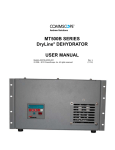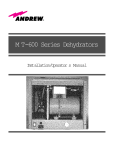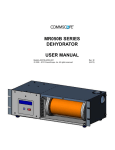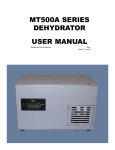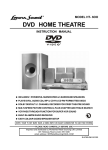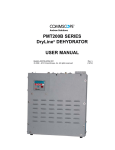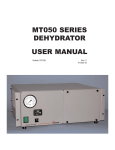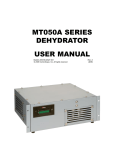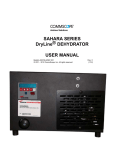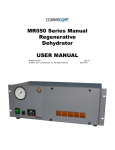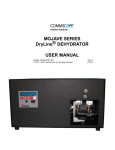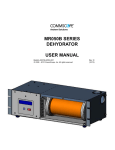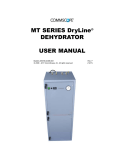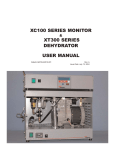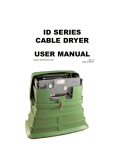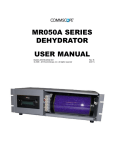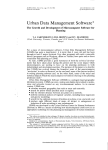Download ODPMT200 SERIES DryLine® DEHYDRATOR USER MANUAL
Transcript
® ODPMT200 SERIES DryLine DEHYDRATOR USER MANUAL Bulletin AE01B-A0467-001 © 2007 - 2013 CommScope, Inc. All rights reserved Rev: E (01/13) ODPMT200 Series DryLine® Dehydrator User Manual TABLE OF CONTENTS Section 1 General Information . . . . . . . . . . . . . . . . . . . . . . . . . . . . . . . . . . . . . . . 3 1.1Introduction . . . . . . . . . . . . . . . . . . . . . . . . . . . . . . . . . . . . . . . . . . . . . . . . . . . 3 1.2Description . . . . . . . . . . . . . . . . . . . . . . . . . . . . . . . . . . . . . . . . . . . . . . . . . . . . 3 1.3Operation . . . . . . . . . . . . . . . . . . . . . . . . . . . . . . . . . . . . . . . . . . . . . . . . . . . . .3 1.4 Triple Alarm Option . . . . . . . . . . . . . . . . . . . . . . . . . . . . . . . . . . . . . . . . . . . . . . 4 Figure 1 - Alarm Label . . . . . . . . . . . . . . . . . . . . . . . . . . . . . . . . . . . . . . . . . . . . 4 Figure 2 - Changing Alarm Outputs: . . . . . . . . . . . . . . . . . . . . . . . . . . . . . . . . . . . 5 1.5 Specifications . . . . . . . . . . . . . . . . . . . . . . . . . . . . . . . . . . . . . . . . . . . . . . . . . .5 Section 2 Installation . . . . . . . . . . . . . . . . . . . . . . . . . . . . . . . . . . . . . . . . . . . . . 6 2.1Inspection . . . . . . . . . . . . . . . . . . . . . . . . . . . . . . . . . . . . . . . . . . . . . . . . . . . . 6 2.2 Controls and Displays . . . . . . . . . . . . . . . . . . . . . . . . . . . . . . . . . . . . . . . . . . . . .6 2.3 Installing the Dehydrator . . . . . . . . . . . . . . . . . . . . . . . . . . . . . . . . . . . . . . . . . . . 7 2.3.1 Slab Mounting . . . . . . . . . . . . . . . . . . . . . . . . . . . . . . . . . . . . . . . . . . . . . . . . . .7 2.4 Power Connections . . . . . . . . . . . . . . . . . . . . . . . . . . . . . . . . . . . . . . . . . . . . . . 7 2.4.1 AC Power . . . . . . . . . . . . . . . . . . . . . . . . . . . . . . . . . . . . . . . . . . . . . . . . . . . . .7 2.5 Connecting the Low Pressure Alarm Output . . . . . . . . . . . . . . . . . . . . . . . . . . . . . .7 2.7 Connecting Dehydrator to the Transmission Line . . . . . . . . . . . . . . . . . . . . . . . . . . .8 2.8 Purging the Transmission Line . . . . . . . . . . . . . . . . . . . . . . . . . . . . . . . . . . . . . . .8 Section 3 Maintenance . . . . . . . . . . . . . . . . . . . . . . . . . . . . . . . . . . . . . . . . . . . . 9 3.1Maintenance . . . . . . . . . . . . . . . . . . . . . . . . . . . . . . . . . . . . . . . . . . . . . . . . . . .9 3.2 Regular Maintenance . . . . . . . . . . . . . . . . . . . . . . . . . . . . . . . . . . . . . . . . . . . . .9 3.3 Preventive Maintenance . . . . . . . . . . . . . . . . . . . . . . . . . . . . . . . . . . . . . . . . . . . 9 3.4 6000 Hour Overhaul . . . . . . . . . . . . . . . . . . . . . . . . . . . . . . . . . . . . . . . . . . . . . 9 3.5 Annual Maintenance . . . . . . . . . . . . . . . . . . . . . . . . . . . . . . . . . . . . . . . . . . . . . 10 3.6 Parts Replacement and Dehydrator Overhaul . . . . . . . . . . . . . . . . . . . . . . . . . . . . 10 3.7 Dehydrator Filter Element Replacement . . . . . . . . . . . . . . . . . . . . . . . . . . . . . . . 11 3.8 Service Restoration . . . . . . . . . . . . . . . . . . . . . . . . . . . . . . . . . . . . . . . . . . . . . 12 Section 4 Troubleshooting . . . . . . . . . . . . . . . . . . . . . . . . . . . . . . . . . . . . . . . . . 13 Figure 3 - Schematic With All Options . . . . . . . . . . . . . . . . . . . . . . . . . . . . . . . . . 14 Figure 4 - Alarm(s) . . . . . . . . . . . . . . . . . . . . . . . . . . . . . . . . . . . . . . . . . . . . . . 15 Section 5 Replacement Parts . . . . . . . . . . . . . . . . . . . . . . . . . . . . . . . . . . . . . . . 16 Section 6 Customer Service . . . . . . . . . . . . . . . . . . . . . . . . . . . . . . . . . . . . . . . . 16 6.1Introduction . . . . . . . . . . . . . . . . . . . . . . . . . . . . . . . . . . . . . . . . . . . . . . . . . . . 16 6.2 In Case of Trouble . . . . . . . . . . . . . . . . . . . . . . . . . . . . . . . . . . . . . . . . . . . . . . 16 6.3 Initial Steps by CommScope . . . . . . . . . . . . . . . . . . . . . . . . . . . . . . . . . . . . . . . 17 6.4 Repair Center Process . . . . . . . . . . . . . . . . . . . . . . . . . . . . . . . . . . . . . . . . . . . 17 6.5 RoHS Inquiries . . . . . . . . . . . . . . . . . . . . . . . . . . . . . . . . . . . . . . . . . . . . . . . . 17 Figure 5 - Hole pattern for locateing J bolts in cement slab. . . . . . . . . . . . . . . . . . . 19 2 ODPMT200 Series DryLine® Dehydrator User Manual They are designed to mount to a slab floor. Optional brackets are available for pole mounting capability. Their front panels feature a pressure gauge, an indicating on/off switch, a resettable circuit breaker, and a run time meter. For easy serviceability, power connections, alarm output connections and all filter elements are accessible from the front of the unit. Section 1 General Information 1.1Introduction This manual contains the information you need to install, operate and maintain your ODPMT200 Series DryLine™ dehydrator. Please take the time to read this manual before attempting to operate or service the unit. The ODPMT200 maintains transmission line pressures at 5.0 lb/in2 (34 kPa). It is intended for standard microwave antenna applications and any other transmission line pressurization requirement that supports a relatively high pressure limit. 1.3Operation ODPMT200 Theory of operation. The ODPMT200 series of DryLine™ dehydrators, while similar in moisture removal technology, operates differently than the rest of the DryLine™ series of dehydrators. In order to provide a constant supply of dry air to small air volume systems, and to maintain an acceptable moisture level in the product air stream, a highpressure reservoir tank is needed. This reservoir tank is connected to a pressure regulator and orifice to yield a fixed output pressure of 5.0 psig and a nominal flow rate of 0.2 CFM. In addition to supplying the output air, the reservoir tank also provides the dry air for the feedback loop. The feedback loop is necessary to maintain the dryness of the membrane cartridge. 1.2Description ODPMT200 Series dehydrators provide dry air for pressurizing small (up to 40 cubic feet, or 560 liters, in volume) antenna and transmission line systems. The dehydrators produce -49ºF (-45ºC) dewpoint dry air at an output rate of 0.2 cubic feet (1.4 liters) per minute. Each dehydrator consists of an electricallydriven air compressor, a membrane dryer assembly, an automatic transmission line pressure sensing system and a low-pressure alarm output housed in a rigid metal chassis. During normal operation, the bleed air in the feedback loop will cause the pressure to drop in the internal reservoir tank, and the ODPMT200 compressor will cycle automatically. These cycles will take place regardless of the system volume or condition of the transmission line the dehydrator is connected to. The rate of these cycles, however, will vary. During the purge cycle, the dehydrator will cycle approximately every 2 to 4 minutes while showing 0 psig on the pressure gauge and providing a constant 0.2 SCFM of dry air. 3 When connected to a very tight system, or the output is capped, the dehydrator will cycle approximately every 60 to 90 minutes and maintain 5.0 psig system pressure while providing close to 0 CFM of dry air. A system that leaks will have a cycle time somewhere in between, depending on the severity of the leaks. ODPMT200 Series DryLine® Dehydrator User Manual Term. The pressure gauge will also reflect a pressure between 0 and 5.0 psig while the output flow is between 0.2 and 0 SCFM. The pressure gauge senses pressure beyond the flow control orifice and will show the actual pressure in the waveguide. During the initial pressurization of the transmission line, the dehydrator will cycle every 2 to 4 minutes with the system at 0 psig pressure. As the dehydrator pressurizes the system, the cycle times will increase until the dehydrator output is balanced with the system leak, at which point the cycle times will stabilize. 1.4 1 2 3 4 5 6 7 8 Function Power Fail Com Power Fail Alarm Humidity Com Humidity Alarm Excess Run Com Excess Run Alarm Low Press. Com. Low Press. Alarm Wire Color Black Red Green Brown Blue White Grey Orange Alarm Definitions: Low Pressure: If system pressure falls significantly below the low-pressure trigger point, the low-pressure alarm sensor will activate an alarm contact. This alarm is an indication of a significant system leak or a dehydrator failure. Triple Alarm Option This optional assembly is designed to provide the additional Excess Run, High Humidity and Power Fail alarms to CommScope Dehydrators. All alarms are Form C dry contacts and are factory set for continuity at alarm. Excess Run: User settable run time to be set in accordance with the normal run time for the particular application. Selectable times are 10, 30, 120 and 240 minutes. See Figure 2 for location of JP3. The external alarm monitoring system (not included) is connected to the terminal strip located behind the cover. A small slotted screwdriver is necessary to make the connections. Power Fail: Activates when power is removed from the dehydrator. This includes turning the power off at the switch. The connection to the alarm strip is as follows, and refer to Figure 1 for correct locations and colors of the wires on the terminal strip. High Humidity: Activates when system or dehydrator output humidity rise above 7.5% relative humidity. At initial installation, this alarm will continue to alarm until the system has been properly purged. ALARM *8* L.P. *7* *6* X.R. *5* *4* H.H. *3* *2* P.F. *1* .5 Figure 1 - Alarm Label 4 ODPMT200 Series DryLine® Dehydrator User Manual 1.5 Figure 2 - Changing Alarm Outputs: Alarm Reset Factory setting Where To Low Normally Pressure Closed (N.C.) Alarm switch center term. N.O., bottom term N.C. Mains (Power) Normally Open (N.O.) Alarm PCB Power Fail Jumper JP6 on Excess Run Normally Open (N.O.) PCB Jumper JP5 on Run Alarm High Humidity Normally Open (N.O.) Jumper JP4 on Alarm PCB Specifications Output Pressure Constant 5.0 psig Output capacity 12.0 SCFH (80Iiters/h) (total, approx.) 0.2 SCFH (1.5 liters/m) Output Dew Point, -49°F (-45°C) or better Operating Temperature Range -30° to +130° F (-34° to +54° C) Low Pressure Alarm 1.0 lb/in2 (6.9 kPa) Electrical Input 115 Vac, 50/60 Hz Output Connector 3/8” polytube, compression Dimensions 18.5” W x 32.0” H x 10.0” D Optional Alarms: 5 High Humidity Alarm Set Point 7.5% RH, factory set Excess Run Alarm Set Point 10 minutes, factory set Power Fail Alarm loss of input power ODPMT200 Series DryLine® Dehydrator User Manual Section 2 Installation 2.1Inspection Open carton. Remove the top piece of corrugated packing. Carefully remove the installation accessories and manual and dehydrator. Check the dehydrator for shipping damage such as dents or loose parts. Pressure Gauge - indicates dehydrator output pressure in psig and kPa. 2.2 ON/OFF Switch - controls compressor and sensors. Light indicates power switch is ON. Controls and Displays Familiarize yourself with the controls and displays prior to installing or testing the dehydrator. To comes from compressor and connects to the filter bowls. Circuit Breaker - white tab indicates a circuit overload. Push to reset. Dehydrator Controls/Displays 6 ODPMT200 Series DryLine® Dehydrator User Manual completed, tie-wrap power-cable in place and tighten the liquid-tite fitting around power cable. See schematic on page 21 for input connections. Un-Time Meter - provides a visual indication of the number of hours of compressor operation and provides validation for the 3000 hour warranty. 2.3 Installing the Dehydrator 2.3.1 Slab Mounting Proper electrical connection is required. It is suggested a licensed electrician be contracted to connect the AC wiring to the unit, if it is connected directly to the mains. Failure to properly connect the power wires could result in a dangerous electrical shock hazard. See the back of this manual page 21 for a drawing showing hole placement and overall size of the unit. 2.4 Power Connections Test the Dehydrator Confirm your dehydrator electrical input matches the available power. Turn the dehydrator ON and check the output port inside the front cover to make sure air is flowing. Ensure an electrical safety ground is installed on the ground stud located adjacent to the power input connector. (It is intended to be customer installed in the field to your halo grounding system.) 115 Vac ODPMT200-89015 ODPMT200-89315 2.4.1 AC Power 2.5 AC units can be connected into a standard 15 amp power receptacle of the proper voltage. Make sure the power circuit is properly grounded. Verify the power switch is OFF. Feed the power cable (not supplied) through the liquid-tite fitting on bottom of unit. Connect power cable to input terminal strip on unit. Use a small flat blade screwdriver to tighten connections on the terminal strip. After power connections are Connecting the Low Pressure Alarm Output To connect the low pressure alarm, open the unit and locate the terminal block (TB-1). 7 ODPMT200 Series DryLine® Dehydrator User Manual Route the wires from the alarm control through the liquid-tite fitting at bottom of unit into the chassis and up to the terminal block Tighten the screws on the terminal block, tie wrap the alarm cable, and tighten the liquid-tite fitting. Note: If the transmission lines have not been purged, continue with section 2.8. Otherwise proceed to Section 3. When a low pressure alarm condition exists dry contacts are activated at terminal block TB-1. An alarm condition exists when pressure falls below 1.0 lb/in2 (6.9 kPa) for all ODPMT200 models. The relay contacts are rated at 2 A (noninductive), 30 Vdc. 2.8 Air in the transmission line system must be replaced with dry air to ensure satisfactory opera-tion of the transmitted signal. Optional alarms (if purchased) will also be located on this terminal block. The alarm connection label, located inside of the front cover, will provide terminal numbers for each additional alarm. 2.7 Purging the Transmission Line 1. Determine the total system volume. 2. Divide the system volume by the flow rate of the dehydrator (12 CFH) to determine the number of hours needed for the purge cycle. 3. Open the far end of the transmission line. Connecting Dehydrator to the Transmission Line 4. Operate the dehydrator for one purge cycle. If it is not possible to open the far end of the transmission line: Check the antenna and transmission line system pressure rating before connecting the dehydrator to the system. 1. Connect the dehydrator to the trans mission line and pressurize the system. Insert one end of the 3/8” polytube feed line tubing into the compression fitting on the dehydrator inside wall, or one of the similar fittings. Tighten securely with a 9/16” wrench. Be careful not to over tighten. Connect the other end of the polytube to the transmission line. 3. Repeat steps 1 and 2 three times to purge the system. 2. Wait 45 minutes while the air absorbs moisture in the system, then disconnect the dehydrator from the transmission line and allow the air to vent. Two air outputs are provided, with individual shut-off valves on the front of the unit. Make sure that the valve is open position for each transmission line connection. If one of the outputs connection is not used, close the valve and leave the port capped. 8 ODPMT200 Series DryLine® Dehydrator User Manual The dehydrator overhaul kit includes parts to overhaul the compressor and critical components in the dehydrator that often become worn over time. Section 3 Maintenance 3.1Maintenance The ODPMT200 Dehydrator requires relatively little maintenance to ensure satisfactory operation over long periods of time. This section outlines the recommended annual preventive maintenance for the unit and the suggested overhaul for every 6000 hours of compressor operation. 3.2 Regular Maintenance These include replacement water filter elements with new o-rings, and a length of white nylon tubing. The ODPMT200 Dehydrator will perform at an optimum if it is routinely checked for correct performance. This checking generally consists of an annual inspection of the condition of the air intake filter and an overhaul after every 6000 hours of compressor operation. Performance of these measures is sufficient to ensure continued reliable operation. 3.3 A compressor overhaul kit is also part of the dehydrator overhaul kit. Preventive Maintenance The annual maintenance of an ODPMT200 consists of a preventative maintenance inspection of the dehydrator and cleaning (or replacement) of the foam air intake filter. These tasks can easily be performed in the field with the unit connected to the transmission line system and with only the front access door opened for maintenance. 3.4 This kit contains a new cylinder and piston, along with new gaskets and head screws. 6000 Hour Overhaul In Case Of Difficulty: If the dehydrator is not operating, refer to the sections on installing and troubleshooting the unit. A run-time meter is provided on the front of the ODPMT200 to indicate the actual number of hours the compressor inside the dehydrator has run. 9 ODPMT200 Series DryLine® Dehydrator User Manual 3.5 Annual Maintenance A loose or damaged connection may result in erratic operation and unnecessary downtime. Refer to the troubleshooting section if an electrical problem is encountered. Inspection includes checking for loose or damaged hoses, fittings and electrical connections. Open the front door and verify that there is no water build-up in the two filter bowls located inside the front cover of the dehydrator. There may be some droplets of water vapor in the filter bowls (the lower portion of each bowl), but there should be only a small amount of liquid in either bowl. Check the ground wire Check that an electrical safety ground is installed on the stud inside the front cover of the dehydrator. This connection point is adjacent the power input connector. (It is intended to be customer installed in the field.) Check the run-time meter Check the run-time meter on the front panel to determine the duty cycle of the dehydrator. If there is excessive water, refer to the troubleshooting section. Replacement of the filter elements in the water filter and coalescing filter is covered in the overhaul section of this manual. Check the electrical connections Check the screw in power input terminals to ensure that the AC power cord is securely terminated. Check the screw-in alarm terminals to ensure that all wire connections are tight. If the dehydrator has been running for more than 10-15% of its installed time, check the system for leaks. Also check the time on the meter to determine if it is time to perform the 6000-hour overhaul. 3.6 Parts Replacement and Dehydrator Overhaul CommScope ODPMT200 Dehydrators are designed to give may years of trouble-free service and require very minimal maintenance. The dehydrator contains, as a standard feature, a run-time meter that records compressor run hours. To ensure continuous and reliable operation, the dehydrator must be overhauled 10 ODPMT200 Series DryLine® Dehydrator User Manual 3.7 every 6000 hours of compressor operation. The kit listed below, contains all of the necessary parts to perform this overhaul. Dehydrator Filter Element Replacement Clean/replace the air intake filter Maintenance Parts The air intake filter protects the compressor from contamination and dust. Periodic cleaning/ replacement extends the life of the compressor. 1. Dehydrator Overhaul Kit 1 ea. AE01K-C0398-015 2. Compressor Air Intake Filter bag of 6, EFLTR-91101 Tools The following tools are used in the maintenance and overhaul procedures. The filter is made of open-cell foam material. It should be cleaned or replaced once a year (or more frequently, if the operating environment is very dusty.) Pull off the filter cover and remove the foam element. (The cover is held in place by two tabs. Use a small screwdriver or a ballpoint pen to release them.) A ballpoint pen, an adjustable open-end wrench, a socket wrench with a 7/16-inch (or 11mm) socket, a No. 2 Phillips screwdriver and a small flat-blade screwdriver. Overhaul Procedure When the ODPMT200 compressor run time reaches 6000 hours (or a multiple of 6000 hours) it is time to replace certain items in the compressor and the air path of the dehydrator. These include the piston cups, piston seals and head gaskets of the compressor, the filter elements in the water and coalescing filters and the tube section connecting the compressor output to the water filter input. Unit Shutdown and Removal In order to perform an overhaul on the ODPMT200, the unit must be turned off and removed from service. As this is being done the low pressure alarm may activate through a reporting alarm system. Personnel monitoring such an alarm should be notified in advance so that they are aware of the fact that service is being performed. It is also necessary to disconnect the dehydrator dry air output from the waveguide system during the overhaul. 11 Wash the filter in running water, squeezing it between the fingers. ODPMT200 Series DryLine® Dehydrator User Manual Squeeze and shake out any excess water and return the element to the filter housing. Do not apply oil or other chemicals to the filter element. make sure the element is seated completely in the housing and then replace the cover. If a new element is used, discard the old element. 3.8 Service Restoration RECOMMENDATION: If the dehydrator overhaul process has taken more than a few hours, it is recommended that the unit be run for one hour into the room, to purge the membrane dryer and tank of any acquired moisture, before reconnecting to the transmission line system. Reverse the steps followed initially to remount the dehydrator. To reconnect the dry air lines; to reconnect the power and alarm cabling; to turn the unit back on; and finally, to open the valves to the waveguide system so that the dehydrator is again providing dry air under pressure to the transmission line system. 12 ODPMT200 Series DryLine® Dehydrator User Manual Section 4 Troubleshooting If you experience difficulty with your dehydrator, use the troubleshooting procedures described below. Caution: Electrical troubleshooting requires access to potentially dangerous voltages and should only be performed by a licensed electrician. Problem/Condition Solution Check the breaker adjacent to the on/off switch. If the breaker is tripped, (white indicator exposed) then reset the breaker. Dehydrator on/off switch does not light, unit does not run. Dehydrator on/off switch does not light, unit runs. If the ON/OFF switch light still falls to light, make sure the unit is plugged in and power outlet is operating. If you still have no light, unplug the unit, remove the unit cover and check for loose connections. Refer to the wiring diagram for proper connections. (See Figure 3 Summary Alarm, Figure 4 Discrete Alarm Wire Diagrams) Disconnect power, remove cover, check for loose connections per the wiring diagram. Replace cover and reconnect input power. If condition persists, replace ON/OFF switch. Pressurize lines with the dehydrator, turn shut-off valve to the off position and observe pressure gauge. The pressure gauge should read approximately 5.0 psig and the alarm should clear. If alarm does not clear, remove cover and verify wiring to low pressure alarm switch. Low-pressure alarm activated. If the pressure does not stay constant after shutting off the valve, apply leak detector to isolate the leak in the dehydrator (exercise care when applying solution not to wet wiring or electronics). (See Figure 6 Pneumatic Diagram) With dehydrator isolated from transmission line, observe pressure in transmission line. If pressure drops, use a leak detector solution to locate leaks in the transmission line. Repair leaks if possible. (See section 6) If the problem persists contact CommScope Customer Service. Compressor does not turn. Check the breaker adjacent to the on/off switch. If the breaker is tripped, (white indicator exposed) then reset the breaker. Check power switch to make sure that it is on and lighted. Check input power polarity and voltage per wiring diagram. Circuit breaker tripped. Check wiring connections per wiring diagram. If breaker trips again, replaces the breaker. If the replacement breaker trips contact CommScope Customer Service. (See section 6) Filter bowls show excessive water. Assure that the drain line tubing (exiting the bottom of the unit) is not clogged. When the compressor cycles off, air and moisture should run out of the drain line. (See Figure 6 Pneumatic Diagram) 13 Figure 3 - Schematic With All Options ODPMT200 Series DryLine® Dehydrator User Manual 14 Figure 4 - Alarm(s) ODPMT200 Series DryLine® Dehydrator User Manual 15 ODPMT200 Series DryLine® Dehydrator User Manual Section 5 Replacement Parts Section 6 Customer Service 6.1Introduction The following is a list of the replacement parts for the ODPMT200 series dehydrators: CommScope provides in-warranty and outof-warranty repairs as well as dehydrator and compressor overhauls from several Repair Centers. Coordination of these services is provided through the nearest Sales Office or Customer Service Center. The Center is also prepared to help you with the following: Description (For units before Rev J mantain existing filters) Inlet Filter EFLTR-20201 ODPMT200-8XXXXAE01J-A0731-001 Filter Bowl (only) AE01J-A1978-101 Water Filter Element AE01J-A1978-203 0.01 micron Coalescent Element AE01J-A1978-201 Overhual or Upgrade (For units before Rev J to bring them up to Rev J) Upgrade Kit AE01K-A0873-001 (For units Rev J and above) Overhual Kit PMT200B-KIT-OVRHL Solenoid Kit PMT200B-KIT-SOLND Filter Element Kit PMT200B-KIT-ELMNT CompressorAE01J-A2022-001 6.2 • Technical Assistance • Troubleshooting • Repairs • Loaner Units • Spare Parts • Installation Materials • System Accessories In Case of Trouble The first step you should take if trouble develops using a dehydrator is to read the operators manual and follow the trouble isolating procedures given in it. If the steps in the manual do not identify and remedy the problem, then contact an CommScope Customer Service Center for 24– hour telephone assistance. Record the Model Number (e.g. ODPMT200) and Serial Number from the product label, as you will be asked for these when you call. Two main locations are currently available to help: From North America Telephone: 1-800-255-1479 Fax (U.S.A.): 1-800-349-5444 International Telephone: +1-779-435-6500 Fax Number: +1-779-435-8579 Web Access Internet: www.commscope.com email: #[email protected] 16 ODPMT200 Series DryLine® Dehydrator User Manual 6.3 Initial Steps by CommScope can issue a NEW RMA number to identify your return and create the appropriate credit to your account. Damages to loaner will be deducted from the P.O. When your call or fax communication is received, the CommScope staff will work with you to pinpoint the possible cause of trouble. If the pressurization equipment is suspect, they will: 6.4 • ask for your unit Model Number and Serial Number • check the warranty status of the unit • advise the availability of a loaner unit • provide an estimate of the cost for inspection and repairs, if the unit is out–of–warranty • fax a Return Material Authorization Sheet to you. PACKING INSTRUCTIONS: Pack your unit securely for shipment to the Repair Center. If you received a loaner unit, we suggest you use the box and packing materials to return your unit. Otherwise we have factory packing materials available for a nominal fee. Enclose a completed copy of this form inside the box and clearly mark your Company Name and RMA: XXXXXXX on outside of the box. Address the box to the following Ship–To Address: CommScope PRESSURIZATION SERVICE CENTER RMA# XXXXXXX 11312 S. PIPELINE RD. EULESS, TX. 76040-6629 Repair Center Process A method of Payment must be provided prior to issuing of RMA regardless of warranty status. Please note, Units received with Biological/ animal contamination will be returned unrepaired or scraped after notification and you will be invoiced for inspection and freight. IN–WARRANTY REPAIR: Most CommScope pressurization products carry a warranty of one to three years, depending upon model number. Warranty details are available on our web page. If your unit falls within its warranty period, inspection and repairs will be performed at no charge and the unit will be promptly returned to you. If a warranty unit is deemed no problem found an inspection fee and freight will be charged to the customer. CONTACT NUMBERS: If you have any questions about the repair process or status of your unit, please contact us directly through one of the following methods – Telephone (below) TEL:817-864-4150 817-864-4155 OUT–OF–WARRANTY REPAIR: We will inform you with the cost of repair and obtain your approval to proceed with repairs or, if you elect not to have the unit repaired, your instructions on disposition of your unit. When repairs are complete, we will return your unit and invoice you for the inspection charge, materials used for the repair and labor applied to complete the repair. If you elected not to repair the unit, we will invoice you for the inspection and freight charge if unit is to be returned. FAX:817-864-4179 6.5 RoHS Inquiries For inquiries on RoHS please contact the following: LOANER UNITS: Loaner units are available from the repair center to maintain your system while repairs are being performed. If you feel you need a loaner, please contact us at at one of the numbers listed under contact numbers. A P.O. for the full value of the unit must be issued prior to shipment. Also contact us when the loaner is ready to be returned so that we 17 CommScope Inc. Corke Abbey, Bray Co., Dublin, Ireland Attn: Legal Department ODPMT200 Series DryLine® Dehydrator User Manual This page was left blank 18 8.00 1.50 5.00 4X 0.43 2.25 19 Figure 5 - Hole pattern for locateing J bolts in cement slab. 18.50 14.00 Bottom of Mounting Bracket ODPMT200 Series DryLine® Dehydrator User Manual ODPMT200 Series DryLine® Dehydrator User Manual This page was left blank 20




















